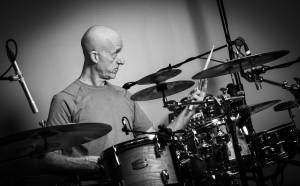TEACHING PHILOSOPHY
I will help you achieve your drumming goals, beginning by working on music of your choosing. Learning your favorite songs can be a great way to start to understand the instrument. However, I also stress the importance of learning all aspects of the drums. I think that this quote from Tony Williams, who is widely regarded as one of the most important and influential jazz drummers of the 20th century, is significant:
“If you’re going to pick just one style of playing and you can only play that way, that’s what you want to do … I don’t discourage that. But I think that drumming is more important than style. When I’ve given lessons or clinics, I try to emphasize that learning how to play the drums is more important than having your own style. Really knowing what the drums can do and the scope and range of the instrument is more important.”
— John Ephland; Traps magazine; Spring 2009.
That’s why my students learn on a full professional drum set — because I feel that it is important for them to get to know all the instruments in the kit and what they sound and feel like, to experiment, and to have fun! The drum set is a powerful instrument, and drummers know the incredible, primal feeling that comes from playing that instrument. There’s something about hitting a drum!
Harnessing that power through technique and playing for the song — which is different from just playing loud or as fast as possible — is also emphasized in my studio. I believe that the drummer is there to collaborate with the other players and to support the music, not simply to show off. Only by really listening to the other players in the group can we begin to comprehend the drummer’s role in an ensemble, and go beyond the mechanics to bring something special to the music. Even during drum solos, I stress playing musically and relating the solo to the song. Playing for the song and always making it groove is my ultimate goal in every situation.

Peter counting along with a student
However, this takes more than hitting the drums at the right time — it takes mastery, sensitivity, and musicianship. I will strive to help you on your way to becoming a “complete drummer” — discussing posture; playing in an ergonomic way for the least amount of stress to your body; mastering the rudiments of rhythm; learning to read music notation; transcribing drum beats; and exploring the rhythmic elements of different styles, from rock and R&B to jazz, blues, and Latin rhythms.
Listening to music cannot be stressed enough. I encourage all my students to listen to anything and everything. A majority of my time is still spent seeking out and soaking up great music. This can be done away from the drum set and outside of drum lessons — anytime.
However, in listening to music together during lessons, I can help you to hear the different instruments that make up the drum set and their rhythmic patterns, and how the music from other instruments complements or contrasts with the drum set. By doing this, you will develop the ability to listen to any kind of music and understand the mechanics of the drums within that style.
So, if you want to learn how to play the drums — really know “what the drums can do and the scope and range of the instrument” (to quote Tony again), experience and explore the possibilities of a professional drum kit, become a master of the instrument and the medium, know how to play in different styles, know how to “play for the song,” and become a valuable collaborator and communicator, I’m your guy!
